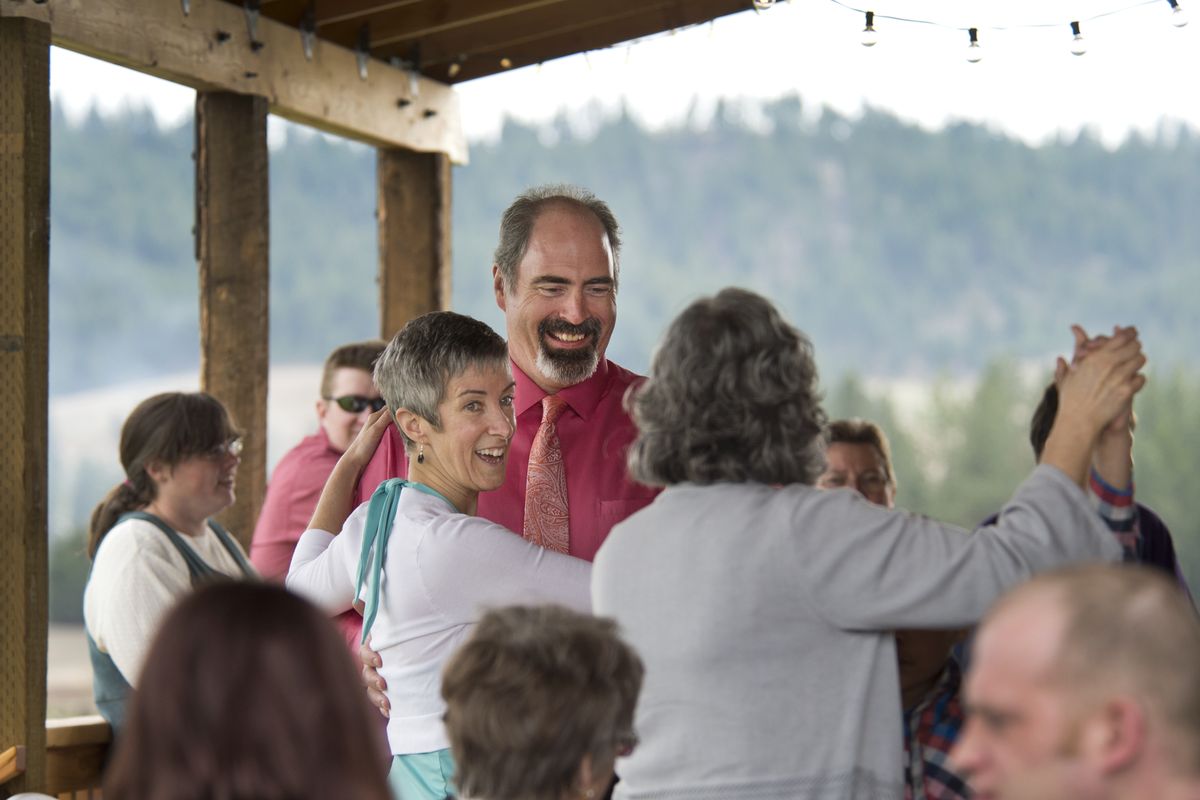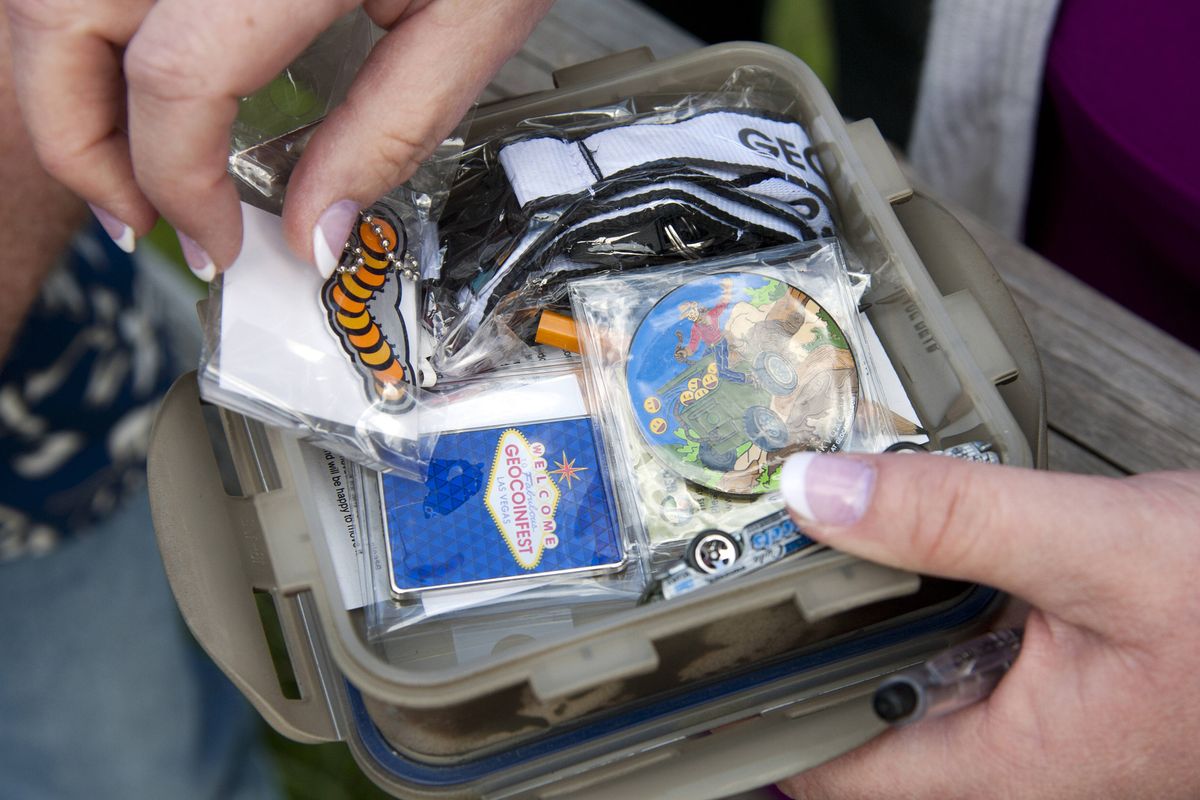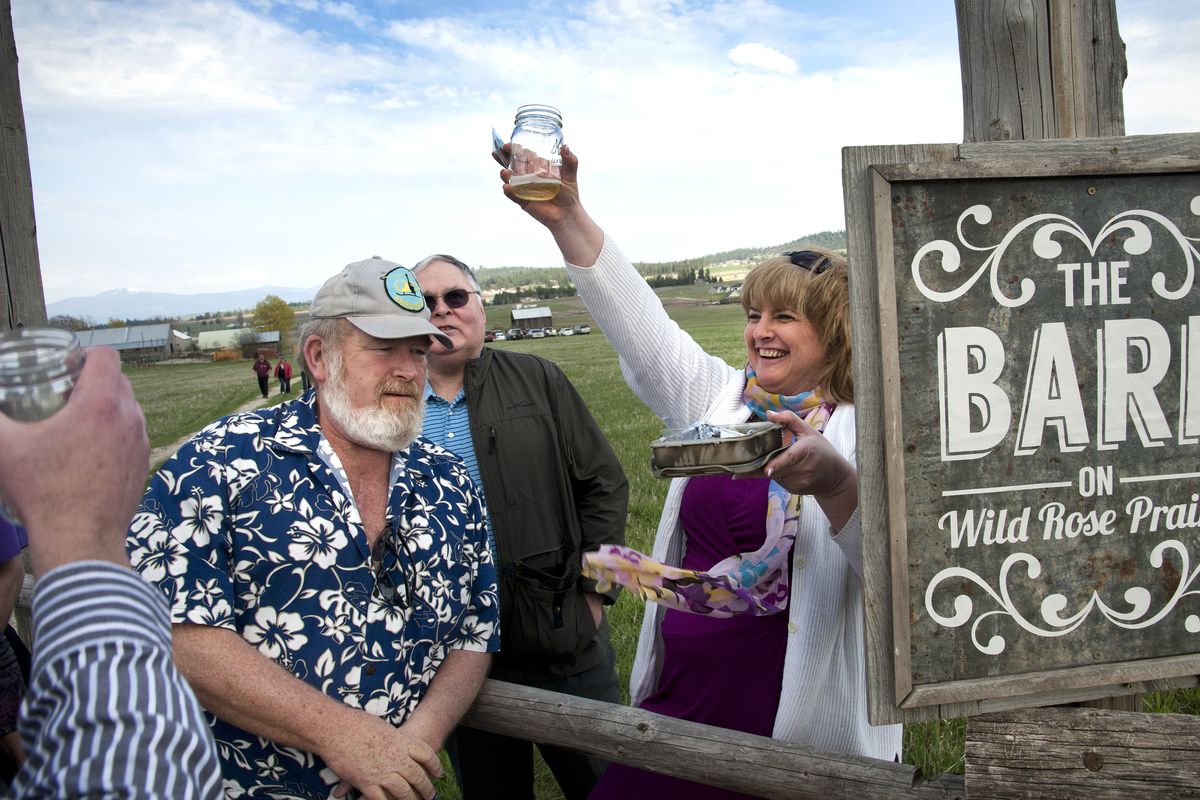Cache of the day
Devoted geocachers revel in the thrill of the hunt
Jacquie Vaugh, of Issaquah, Wash., raises her beer to celebrate finding the hidden cache on April 19 at the Barn on Wild Rose Prairie, with Mark Whitehead, left, of Olalla, Wash., and Larry Noll, center, of Spokane Geocaching. Wedding guests of J.D. Parkman and Lisa Breitenfeldt were sent an alert with the location of the cache at the base of the sign. (photos by Dan Pelle)
Bill Pierce accidently stumbled across geocaching while hiking Shoshone County’s Pulaski Tunnel Trail.
Pierce wanted to double-check the name of the creek that runs down the ravine before he entered the day’s adventure in his journal. Google found him the West Fork of Placer Creek and included a description of a geocache location, where a cache – or a hidden container – was stashed along the trail.
“What the heck is that,” Pierce remembers thinking, fascinated by the idea that there are 2.3 million geocaches hidden across the world, including more than 2,000 in Spokane County. Players who hide caches share the location online at www.geocaching.com.
All anyone needs is a GPS or a smartphone to plug in the GPS coordinates (latitude and longitude) of a location then navigate the directions to find the hidden geocache, which usually includes a log book and perhaps a trinket or coin.
Intrigued, Pierce bought a GPS to find his first cache on Mica Peak and check out Old Glory – the oldest known Ponderosa pine in the Inland Northwest – a marvelous natural treasure he wouldn’t have seen if not for geocaching. That was in 2010. Today the Spokane retiree has found more than 1,000 geocaches, including the one hidden on the Pulaski trail.
For Pierce, 69, this techie game of hide-and-seek is best when it includes a large dose of history or geologic wonder. Or just odd manmade wonders, like the life-size statues of lions scattered through the fields north of Spokane near Mount St. Michael on Fairview Road.
The hobby is prevalent among baby boomers, especially men, but is growing in popularity with woman and, thanks to new GPS apps for smartphones, the younger crowd. In the beginning, the majority of caches were located in rural settings but today there are more urban locations including many in Spokane’s Riverfront Park.
“There’s something woven in our DNA that geocaching unlocks,” wrote Eric Schudiske of Geocaching.com in an email interview. “It empowers people to discover the world around them, find new parks, uncover little-known local history or just get off the couch and get outdoors.”
Geocaching is popular with photographers and, from reading online blogs about various geocache finds, people incorporate caching into hunting, horseback riding and mountain biking adventures, as well as business trips. Schudiske added that it’s a great family hobby, especially because children love to find treasure, play outside and discover the world.
Pierce, a retired Spokane County appraiser who traveled far-reaching roads for his job, resembles what Lisa Breitenfeldt calls the stereotypical geocacher: a middle-age male, 40 to 70 years old, who works in IT or uses information technology for a career field and who enjoys the outdoors. Breitenfeldt owns Spokane’s geocache store, Cache Advance, which was one of the first brick-and-mortar stores in the country.
“People think it’s a kid’s game but it’s not,” said Breitenfeldt, 48. “One of the really neat things of geocaching is it’s like a choose-your-own adventure. You can do it for 20 minutes or you can do an all-day challenge.”
Breitenfeldt read about geocaching in 2002 while working on her master’s degree. The hobby was new, blossoming after the government removed Selective Availability from GPS in 2000 allowing civilians to use the navigation signals without errors.
Today geocaching is a lifestyle for Breitenfeldt. Besides owning the store and warehouse, she met her husband while geocaching. She and J.D. Parkman got married this month; the reception in Deer Park was attended by geocachers from across the Northwest and Canada and included finding a cache and drinking beer. The “geowedding” even had its own cache site on geocaching.com, guiding friends to the hidden treasures.
“It’s fantastic to explore your hometown, your state and your world,” she said. Of course there was geocaching planned on the honeymoon.
Geocaching.com is the hub, the website that provides coordinates to all geocaches around the world. Players choose a cache on the site and then plug the coordinates into their GPS device, which helps in finding the hidden geocache. Caches are found even in Antarctica, where the coordinates of one cache will gradually change because the cache is on an emergency shelter on a glacier that is slowly moving.
Caches can be anything from a Tupperware container to a film canister or a fake rock with a secret compartment. There is always a log book to sign and it can contain any number of items left by visitors and the cache owner. Geocaching rules allow you to take an item from the cache but only if you leave something of equal or greater value in return.
Some of the cache items are trackable, etched with a code that players can use on the website to log its movement. Some of these trackables, also known as travel bugs or geocoins, have traveled hundreds of thousands of miles, according to geocaching.com.
Some geocaches are more complicated than just plugging in coordinates. Sometimes cachers have to figure out a puzzle or mystery to find the cache. Others are multi-cache, meaning that you have to track two or more locations before finding the final container with the logbook inside.
Pierce is a self-proclaimed “summer warrior” who looks for caches at least once a week in good weather, and sometimes goes daily depending on his mood. He always caches when visiting his family homestead in eastern Montana and another family site in south central Oregon.
He warns cachers, especially those hiking into wild and remote country, to prepare and take enough water, food and clothing. Rough terrain and bad directions got him stuck in a deep canyon in Oregon, and it took him nearly three hours to find his car. He never did locate the cache. He’s planning a return trip.
“At my age, I was thinking this is ridiculous,” Pierce said. “I only had one slurp left in my canteen.”
His big piece of advice to fellow geocachers: “Always make sure someone knows where you are.”


